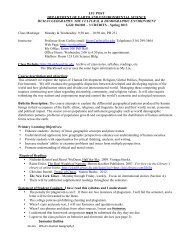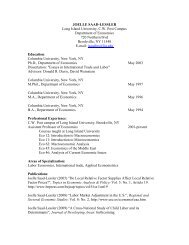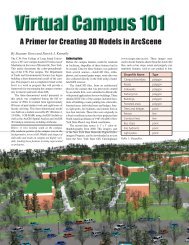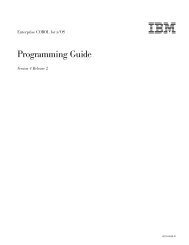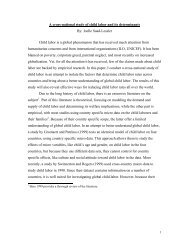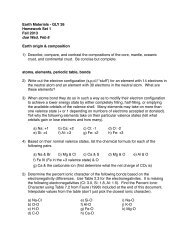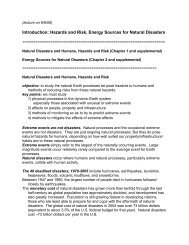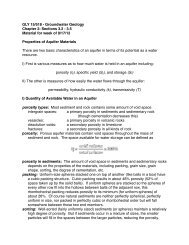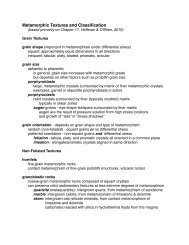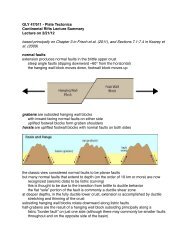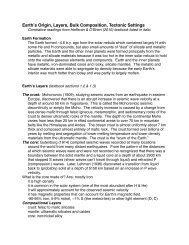Social Engineering - Myweb @ CW Post - Long Island University
Social Engineering - Myweb @ CW Post - Long Island University
Social Engineering - Myweb @ CW Post - Long Island University
Create successful ePaper yourself
Turn your PDF publications into a flip-book with our unique Google optimized e-Paper software.
ule-based, and knowledge based. Skill based behavioroccurs without conscious thought. Rule based behavioroccurs in familiar work situations, and follows a storedrule or procedure. Operators are aware of alternatechoices of actions and make choices among them.Knowledge based behavior involves formulation of goals.The operator has a mental model of his environment.Plans of action are tested against goals.Wickens’ model of information processing iscomposed of critical stages of information processing: (1)short term sensory storage of receptor information, (2)perception, decision and response selection, and (3)response execution [Wickens 92]. Stage one does notneed conscious attention, has a very short time span,normally less than ten seconds, and the informationdecays rapidly. Stages two and three are supported byworking and long-term memory. Each stage of processingtransforms data and consumes time. Memory resources,information decay, and capability to perform actions inrapid succession, and simultaneous use and speed ofprocessing resources limit human activity.Based on this and other work, Owens defined amodel of Situation Assessment and Decision Making[White et al. 98]. Figures 3 and 4 represent aspects of thismodel in Dataflow Diagram (DFD) and State TransitionDiagram (STD) format.individual, task, environmental,& organizational variablesInputs(HCI info,Environment,Communication)AssessSituationSituation Modelinternal effectsof actionsDecideActDecisionactionsTask variables include task criticality demands, taskworkload demands, time stress demands, cost to acquireadditional information (in terms of fiscal cost, time, orhuman resources) and consequences of decisions(including a delayed decision, no decision, or error).System variables include information quality, quantity,and integrity, and productivity enhancement.Environmental variables include noise and otherdistractions such as lighting, heat, and cold.Organizational variables include cost containmentdemands, schedule demands, regulations/policy demands,lack of manpower/team members, consequence ofdecision on others, poor communication within group,and poor interactive team skills. Internal and externaleffects resulting from decisions and resultant actions canaffect future situation assessment.Situation Assessment consists of Perceiving,Comprehending, and Projecting Future States, whichoccur continuously and in parallel (see figure 4). SituationAssessment leads to Situation Awareness, during which aperson’s mental model is equivalent to the SituationModel in figure 3.PerceivingSituation AssessmentComprehendingProjectingFutureStatesDecision MakingSituationAwarenessDecidingActingexternal effects of actionsFigure 3. Situation assessment and decisionmakingprocess, data flow diagramOwens proposed four classes of variables that canaffect situation assessment and decision analysis. Theseinclude individual variables, task variables, environmentalvariables and organizational variables. Individualvariables can be psychological or physiological.Psychological variables include lack of experience, lackof knowledge or expertise, lack of confidence ininformation, lack of flexibility or adaptability, lack of riskmanagement ability, and lack of motivation to perform.Physical variables can include fatigue from sleep loss orwork-rest cycle demands.Figure 4. Situation assessment and decisionmakingprocess, state transition diagram8. High level system dynamics model ofsituation assessment and decision-makingFigure 5 shows a pattern for using System Dynamicsto model the effect of system variables on situationassessment and decision-making. This figure is generic,and would be tailored for each organizational decision.The model in figure 5 illustrates the feedback looprelating situation awareness, the level of risk in decisionmaking,the actual system or organization state, andavailable information about the system or organizationstate.5
At the start of model execution, the System orOrganization State is defined at a specific level. Forexample, the organization is undermanned by 10%. Basedon being undermanned, the Level of Information aboutthe actual System or Organization State might be less thanperfect. This would be affected by such variables asfatigue from overwork, lack of motivation from having totake on the responsibility of others, task workloaddemands, time stress demands, cost in time and humanresources to acquire additional information, schedule andpolicy demands, poor communication due to workloaddemands, and environmental distractions such as applyingfor other job positions.If the Level of Information about the actualOrganization State is insufficient, Situation Assessmentwill reflect that. Situation Assessment is affected by theabove variables, as well as individual psychologicalvariables such as lack of experience, lack of knowledge,lack of confidence in the information, lack of adaptability,and lack of communication skills. Variables describingcomputer-aided support, such as the quality of theinformation display, and the quality, quantity, andintegrity of information in the system will also be factorsin Situation Assessment. The Level of Risk in Decision-Making will be dependent on Situation Awareness andalso on other variables, such as the consequence of adelayed decision, no decision, or erroneous decision. TheLevel of Risk in Decision Making results in actions thataffect the System or Organization State. The model isexecuted iteratively to determine the impact of differentvariables on the Organization State.9. Using process modelsAfter building process models, engineers shouldprove that the model works for a similar existing systemprior to model usage. It is only in this manner that theybuild confidence in the model. During model usage, themodel should be periodically verified as the system ororganization process, and factors affecting that process,may change. Engineers restructure the model until modelinputs ask the correct questions. They verify datacharacteristics, such as individual, environmental, taskand organizational variables, and time related variables.Had those responsible for the LAS system usedprocess models that reflected reality, and collectedappropriate and accurate data, they would have found thatthe number of calls could overload the system, and thatthe time from a call for an ambulance to patient pickupwould be longer than anticipated. They should havefound where the process and resources were inadequate.They could have determined at what point the systemwould fail, and planned how to avert failure.(SituationAssessmentVariables)Level of SituationAwareness(Decision-MakingVariables)Level of RiskLevel of Info about ActualSystem / Org. State(Knowledge Acquisition & PresentationVariables)Decisions/Actions(Initial State)Actual System /Organizational StateFigure 5. System dynamics model, variablesaffect situation assessment and decision making10. Conclusions and future workThis paper identifies methods, which would benefitstakeholders in building computer-based systems thatsupport their organization. The paper models the humansituation assessment and decision-making process. Asituation model was defined to be equivalent to situationawareness and to represent the current state of knowledgethat a human / agent / organization possesses concerningelements in a dynamic task environment. It is well knownthat human situation assessment and decision-making canbe affected by numerous internal and external influences.A set of variables was incorporated into the model, whichcan act internally or externally to affect situationassessment and decision-making in agents and teams.Future work will (1) further delineate the SystemDynamics model for Situation Assessment and Decision-Making (2) integrate methods for modeling SituationAssessment & Decision Making, and (3) analyze theeffectiveness of described methods in predicting the effectof automated systems on social organizations. The list ofvariables that affect situation assessment and decisionmakingwill be extended during this work.Over time, process modeling methods should lead tobetter understanding of the impact, both positive andnegative, that a computer system will have on people andorganizations.11. References[Abdel-Hamid 96] Abdel-Hamid, T.K., “The Slippery Path toProductivity Improvement”, IEEE Computer, July 1996, pp. 43-52.6
[Abdel-Hamid and Madnick 91] Abdel-Hamid, T. & Madnick,S. Software Project Dynamics: An Integrated Approach,Englewood Cliffs NJ, Prentice-Hall, 1991.[Armenise 93] Armenise P., A Survey and Assessment ofSoftware Process Representations Formalisms, InternationalJournal of Software <strong>Engineering</strong> and Knowledge <strong>Engineering</strong>,3(3), 401-426, 1993.[Armitage et al. 94] Armitage J.W., Briand L., Kellner M.I.,Over J.W., and Phillips R.W. Software Process DefinitionGuide: Content of Enactable Software Process Representations,Special Report, CMU/SEI-94-SR-21, Software <strong>Engineering</strong>Institute, Carnegie Mellon <strong>University</strong>, Pittsburgh PA, 1994.[Bloom 56] Bloom, B. S. et al., 1st ed. Taxonomy ofEducational Objectives; the Classification of EducationalGoals, by a Committee of College and <strong>University</strong> Examiners,<strong>Long</strong>mans, Green, NY, 1956.[Bretschneider 93] Bretschneider F., A Process Model forDesign Flow Management and Planning, PhD Thesis,<strong>University</strong> Kaiserslautern, 1993.[Cannon-Bowers et al. 96] Cannon-Bowers, J.A., Salas, E., andPruitt, J. S., "Establishing the Boundaries of a Paradigm forDecision-Making Research," Human Factors, 38(2), 1996, pp.193-205.[Curtis et al. 92] Curtis B., Kellner M., and Over J., ProcessModeling. Communications of the ACM, 35(9), 75-90, 1992.[Dalcher 01] Dalcher, Darren, “Ambulance Despatch Systems:the Melbourne Story”, Proceedings of the Eighth Annual IEEEInternational Conference and Workshop on the <strong>Engineering</strong> ofComputer Based Systems, IEEE, 2001.[Forrester 68] Forrester, Jay W., Principles of Systems, Text andWorkbook, Second Preliminary Edition, Wright-Allen Press,Cambridge, Mass., 1968.[Hammer and Champy 93] Hammer, M., and Champy, J.,Reengineering the Corporation, Harper Business, New York,1993.[Hansen 97] Hansen G. A., Automating Business ProcessReengineering, Prentice Hall, Upper Saddle River NJ, 1997,ISBN 0-13-576984-1.[Harel and Gery 97] Harel, D., and Gery, E., “ExecutableObject Modeling with Statecharts”, IEEE Computer, 30(7), pp.31-42, July 1997.[Harel 87] Harel, D., “StateCharts: A Visual Formalism ForComplex Systems”, Science of Computer Programming 8, pp.231-278, 1987.[MIL-H-46855] Department of Defense, Military Specification,Human <strong>Engineering</strong> Requirements for Military Systems,Equipment and Facilities, Defense Technical InformationCenter, Washington D.C, 1994.[Nilsson 80] Nilsson N., Principles of Artificial IntelligenceTioga Press. 1980.[Raffo 96] Raffo, D.M., Modeling Software ProcessesQuantitatively and Assessing the Impact of Potential ProcessChanges in Process Performance, Ph.D. Dissertation, UMIDissertation Services, Ann Arbor MI. 1996.[Rasmussen 94] Rasmussen, J., Pejtersen, A. M., andGoodstein, L. P., Cognitive Systems <strong>Engineering</strong>, John Wiley &Sons, Inc., NY, 1994.[Rasmussen 93] Rasmussen J., “Deciding and doing: DecisionMaking in Natural Contexts”, in G.A. Klein, Orasanu,Calderwood, and Zsambok (Eds.), Decision Making in Action:Models and Methods, pp158-171, Ablex, New Jersey, 1993.[Rozenblit and Kocourek 97] Rozenblit, Jerzy W. andKocourek, Christine, “Concepts for Computer Assisted<strong>Engineering</strong> Process Management”, Proceedings of the 1997IEEE Conference and Workshop on <strong>Engineering</strong> of ComputerBased Systems, pp. 405-412, Monterey, CA, March 1997.[Umpleby] Umpleby, S. “Cybernetics of Conceptual Systems”,paper prepared by George Washington <strong>University</strong> for theInstitute for Advanced Studies, Stumpergasse 56, A-1060,Vienna, Austria.[Voss 94] Voss M., IEEE Conference and Workshop on<strong>Engineering</strong> of Computer-Based Systems, Stockholm Sweden,March 1994.[White et al. 98] White, S., Pallack, P., Dorchak, S. Keane, J.,Sztipanovits, J., Davis, J., Rozenblit, J., and Owens, J., AProcess Centered Environment for Complex SystemDevelopment that Emphasizes Situation Assessment andDecision Making, SBIR Report for Naval Surface WarfareCenter, Contract No. C-N00178-97-C-3017, 1998.[Wickens 92] Wickens C. D., <strong>Engineering</strong> Psychology AndHuman Performance (2 nd Ed). HarperCollins, NY, 1992.12.0 Web references[Ithink Website]http://www.hps-inc.com/products/ithink/details.html[Extend Website] http://www.imaginethatinc.com[Martin et al. 01] Martin P., Watson C., and Skinner A., ASimulation of the Mission Crew Workload in a Multi-MissionAircraft, Proceedings of the Winter Simulation Conference,2001.7



